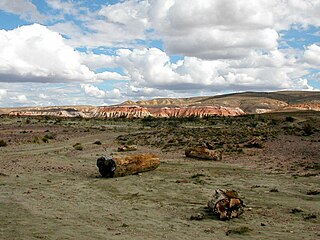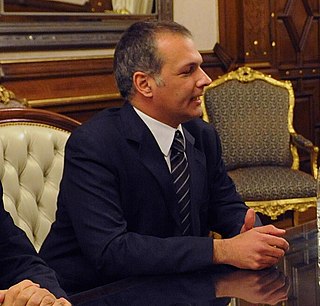
Chubut is a province in southern Argentina, situated between the 42nd parallel south, the 46th parallel south, the Andes range to the west, and the Atlantic ocean to the east. The province's name derives from the Tehuelche word chupat, meaning "transparent," their description of the Chubut River.

Comodoro Rivadavia is a city in the Patagonian province of Chubut in southern Argentina, located on the San Jorge Gulf, an inlet of the Atlantic Ocean, at the foot of the Chenque Hill. Comodoro Rivadavia is the most important city of the San Jorge Basin, and is the largest city in Chubut as well as the largest city south of the southern 45th parallel.

Sarmiento is a town in the province of Chubut, Argentina. It has about 8,000 inhabitants as per the 2001 census [INDEC], and is the head town of the department of the same name. It is located on the so-called Central Corridor of Patagonia, in a fertile valley amidst an otherwise arid region, 140 km west from Comodoro Rivadavia, in the south of Chubut. It sits between two lakes, Lake Musters and Lake Colhue Huapi. Notable attractions are the Petrified Forest and caves with Aborigine hand paintings.

Club Gimnasia y Esgrima de Comodoro Rivadavia is an Argentine basketball and team handball club based in the city of Comodoro Rivadavia in Chubut Province. The basketball team currently plays in the Liga Nacional de Básquet, the top level of the Argentine league system. Its home arena is the Estadio Socios Fundadores.

The Roman Catholic Diocese of Comodoro is located in the city of Comodoro, in the Patagonian province of Chubut in southern Argentina.

The Central Chubut Railway was a British-owned company that built and operated a 1,000 mmmetre gauge railway line in the Argentine province of Chubut in the Patagonia region at the end of the 19th. century.

The San Jorge Gulf is a bay in southern Patagonia, Argentina. It is an ocean basin opening to the Atlantic. Its shoreline spans Chubut and Santa Cruz province. The gulf measures approximately 142 miles (229 km) at its mouth and covers approximately 39 square kilometres (15 sq mi). It is located between Cape Dos Bahías and Cape Tres Puntas.

Ferrocarriles Patagónicos was an Argentine State-owned railway company that built and operated several rail lines in Patagonia region. FP were part of the Argentine State Railway created in 1909 during the presidency of José Figueroa Alcorta.

Agustín Roberto Radrizzani, SDB was an Argentine prelate of the Roman Catholic Church. He served as Archbishop of Mercedes-Luján from 2007 until 2019.

The Assumption of the Virgin Cathedral is a Renaissance-style, Roman Catholic cathedral located in Santa María Square, opposite the Town Hall and the Episcopal Palace, in the center of Jaén, region of Andalusia, Spain.

Martín Buzzi is an Argentine political scientist and politician elected Governor of Chubut Province in 2011.

South African Argentines are Argentine citizens of South African descent or South African-born people residing in Argentina.

The Comodoro Rivadavia and Colonia Sarmiento Railway was an Argentine railway company that built and operated a broad gauge line that connected the port of Comodoro Rivadavia with Colonia Sarmiento in Chubut Province. The FCCRCS -belonging to Argentine State Railway- also connected to Central Chubut Railway.

The Puerto Deseado and Colonia Las Heras Railway was a State-owned railway company that ran between the cities of Puerto Deseado to Colonia Las Heras in Santa Cruz Province. The 283-km broad gauge railway was established with the intention of encouraging settlement in Patagonia, which was sparsely populated at that point. The railway also contributed to the commercialisation of wool in the region.

Mariano Ezequiel Arcioni is an Argentine politician who has served as the governor of Chubut Province since 1 November 2017. From 2015 to 2017, he was the province's vice governor under Mario Das Neves, whose office Arcioni took upon Das Neves's death on 31 October 2017.
Cathedral of San Juan or San Juan Cathedral, and variants thereof, may refer to:

Alfredo Héctor González Luenzo is an Argentine psychologist, journalist and politician, who was a National Senator for Chubut from 2015 to 2021. Luenzo belongs to the regionalist alliance We Are All Chubut, and sat with the Frente de Todos parliamentary bloc in the Senate from 2019 to 2021.

The Legislature of Chubut Province is the unicameral legislative body of Chubut Province, in Argentina. It convenes in the provincial capital, Rawson.

The 1953 Comodoro Rivadavia rail disaster occurred on February 15, 1953, in Punta Piedras, a beach resort near the city of Comodoro Rivadavia in the Patagonian province of Chubut, Argentina. It happened in the branch to Rada Tilly that extended alongside the coast.




















